Introduction
In the rapidly evolving landscape of software development, the integration of DevOps practices emerges as a pivotal strategy for organizations seeking to enhance collaboration and streamline processes. This comprehensive approach not only fosters a culture of shared responsibility between development and operations teams but also emphasizes the importance of automation, continuous integration, and real-time feedback. As organizations grapple with the complexities of modern software delivery, understanding the core principles of DevOps becomes essential.
This article delves into the fundamental aspects of DevOps, offering insights on:
- Laying a solid foundation
- Creating a phased implementation roadmap
- Securing executive buy-in
- Ensuring continuous improvement
By embracing these strategies, organizations can position themselves to thrive in an increasingly competitive environment, delivering high-quality software at an accelerated pace.
Understanding DevOps: Core Principles and Importance
This approach embodies a transformative cultural and technical movement intended to enhance collaboration between development and operations groups, thereby improving both the speed and quality of software delivery as outlined in the devops strategy roadmap. The core principles of development and operations are foundational to this strategy:
-
Collaboration: By dismantling silos between teams, organizations cultivate a culture of shared responsibility. This collaboration is pivotal, as highlighted by industry insights, which underscore that a lack of effective infrastructure management can lead to access request fulfillment taking hours to weeks for 50% of companies. A case study titled 'Collaboration Improvement through Development and Operations' illustrates this point, showing how this methodology enhances collaboration between development and operations for quicker quality releases, ultimately enabling faster delivery of high-quality releases through streamlined workflows.
-
Automation: The automation of repetitive tasks not only reduces human error but also accelerates critical processes, leading to a more efficient workflow. This efficiency is exemplified by Drift, which saves approximately $2.4 million annually on AWS costs through effective automation strategies.
-
Continuous Integration and Continuous Deployment (CI/CD): Regularly integrating code changes and deploying them ensures that software remains in a releasable state, facilitating rapid updates and enhancing overall delivery speed.
-
Monitoring and Feedback: Ongoing observation of applications and infrastructure produces valuable insights that guide enhancements and promote a responsive development environment.
Understanding these principles is crucial, as they offer the framework for a successful devops strategy roadmap. As noted, 'DevOps helps in improving collaboration between development and operations for quick quality releases,' highlighting the significance of these practices. By adopting a collaborative approach, organizations position themselves to navigate the complexities of modern software development, aligning with the latest trends and ensuring timely, high-quality releases.
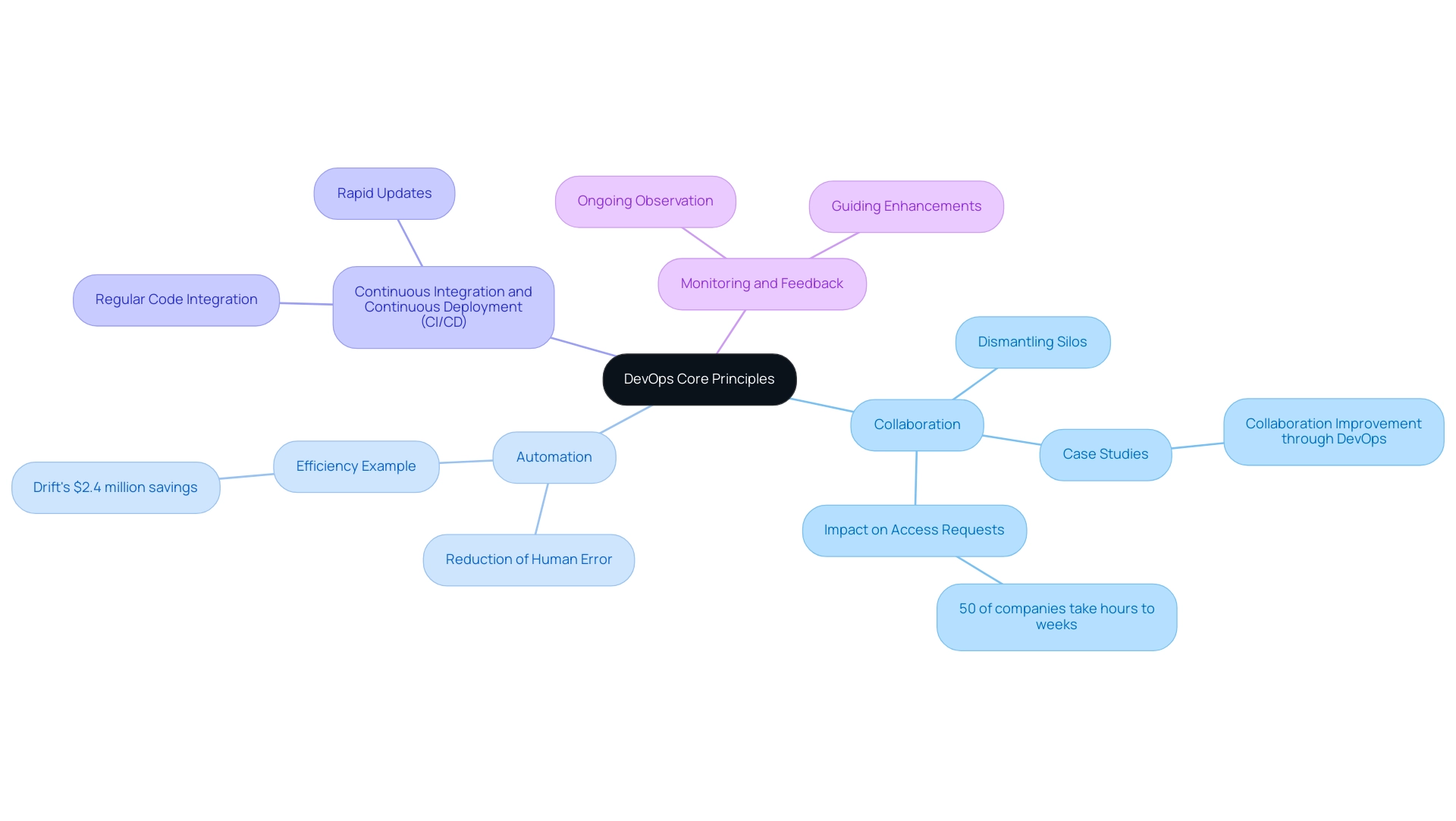
Laying the Groundwork: Assessing Current State and Defining Objectives
To establish a robust foundation for your development and operations strategy, consider the following critical steps:
-
Conduct a Current State Assessment: Begin by thoroughly evaluating existing processes, tools, and group dynamics. This assessment should identify both strengths and weaknesses in your current development and operations practices, which is crucial for informed decision-making. Recent statistics reveal that 50% of companies face delays in access request fulfillment due to inadequate infrastructure, underscoring the need for a meticulous assessment to enhance operational efficiency.
-
Engage with Teams: Actively gather insights from development, operations, and other relevant stakeholders. This engagement will provide a comprehensive view of current workflows and highlight prevalent pain points that may hinder efficiency. For instance, integrating access management into development and operations workflows can expedite access and enhance security, as demonstrated in case studies where companies reported significant improvements in fulfillment times.
-
Define Clear Objectives: Establish specific, measurable, achievable, relevant, and time-bound (SMART) objectives that align with overarching business goals. For instance, aim to reduce deployment time by 30% within six months. According to the DORA 2022 State of DevOps survey, more than half of teams surveyed reported utilizing methodologies to deploy containers, emphasizing the importance of clearly defined objectives in driving successful outcomes.
-
Document Findings: Compile a detailed report summarizing your assessment and the defined objectives. This document will serve as an essential reference point during the creation of the devops strategy roadmap, ensuring alignment and focus as you progress your initiatives.
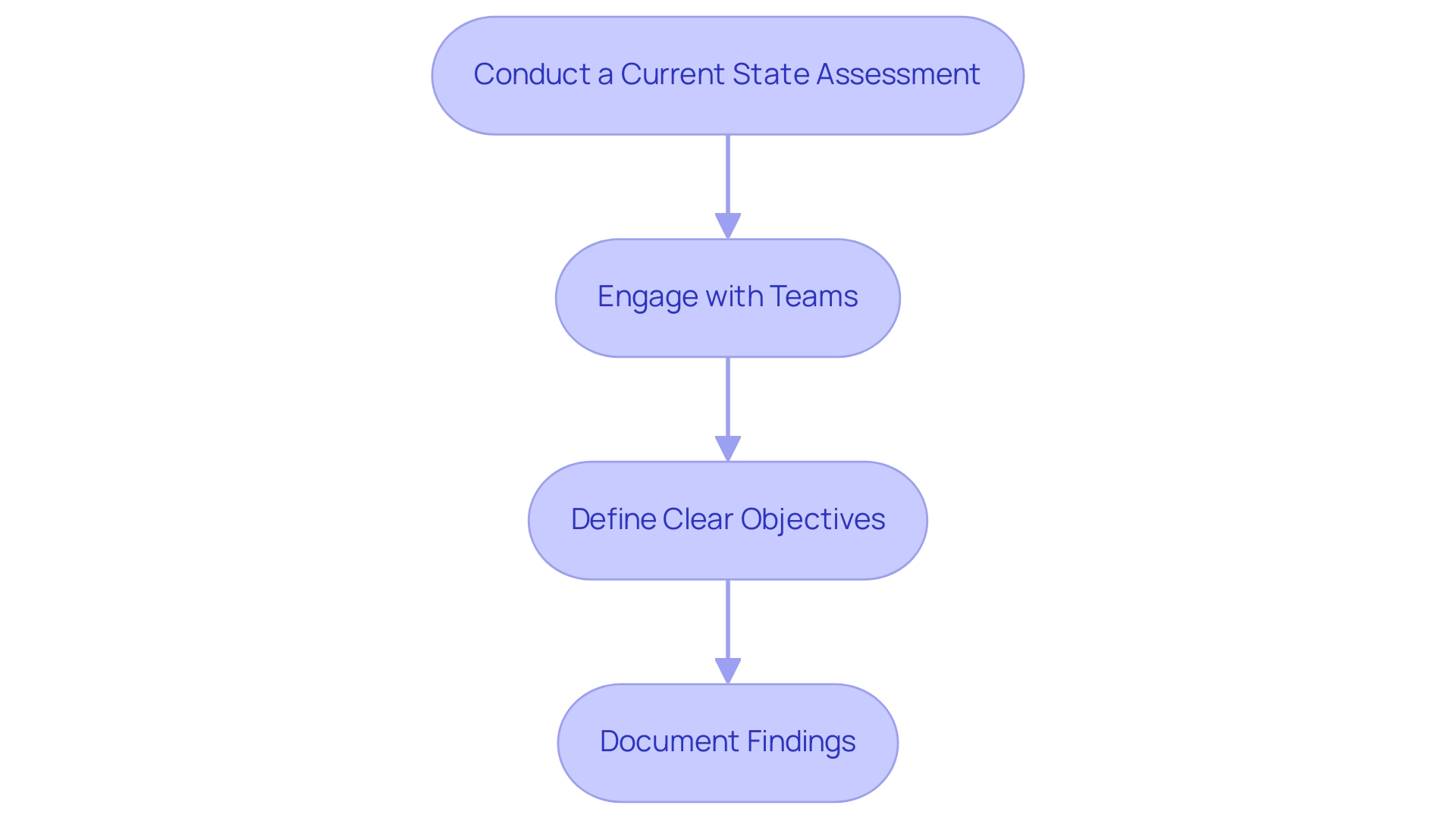
Creating a Phased Roadmap for DevOps Implementation
To create a phased DevOps strategy roadmap for the implementation of development and operations, it is essential to adopt a structured approach that not only facilitates execution but also ensures adaptability to evolving market demands. Follow these steps:
- Identify Key Phases: Begin by delineating the implementation into distinct phases, such as Planning, Development, Testing, Deployment, and Monitoring. This segmentation allows for focused efforts and clear tracking of progress.
- Set Milestones: Define specific milestones for each phase to ensure alignment with organizational objectives. For instance, aim to complete the Continuous Integration/Continuous Deployment (CI/CD) pipeline setup within the Development phase to enhance workflow efficiency. This approach is feasible, as startups can implement the entire development and operations pipeline from scratch without breaking existing processes.
- Allocate Resources: Assess and allocate the necessary resources for each phase, including skilled personnel, advanced tools, and budget considerations. It is crucial to recognize that DevOps is not a magic solution; training and adaptation are necessary for effective implementation. This step is vital for maintaining momentum and achieving set goals.
- Establish Timelines: Develop a realistic timeline for each phase, incorporating flexibility to accommodate unforeseen challenges. A well-organized timeline allows groups to manage expectations while staying responsive to consumer demands.
- Communicate the Roadmap: Effectively share the roadmap with all stakeholders to foster alignment and secure buy-in across the organization. Clear communication enhances collaboration, as emphasized by James Walker from Platform Engineering, who notes that it delivers enhanced collaboration, automation, and controls to simplify and accelerate the provisioning of cloud-based infrastructures.
Furthermore, prior to adopting new workflows, it is crucial to evaluate if the group is ready and eager to acquire new skills, as emphasized in the case study named 'Qualifying Staff for DevOps.' This case study demonstrates that continuous education is essential for groups to react swiftly to market demands, offering a competitive edge.
By following these steps outlined in their DevOps strategy roadmap, organizations can ensure that they not only execute a cohesive approach but also empower their teams through continuous education and skill development, positioning themselves competitively in a rapidly changing technology market.
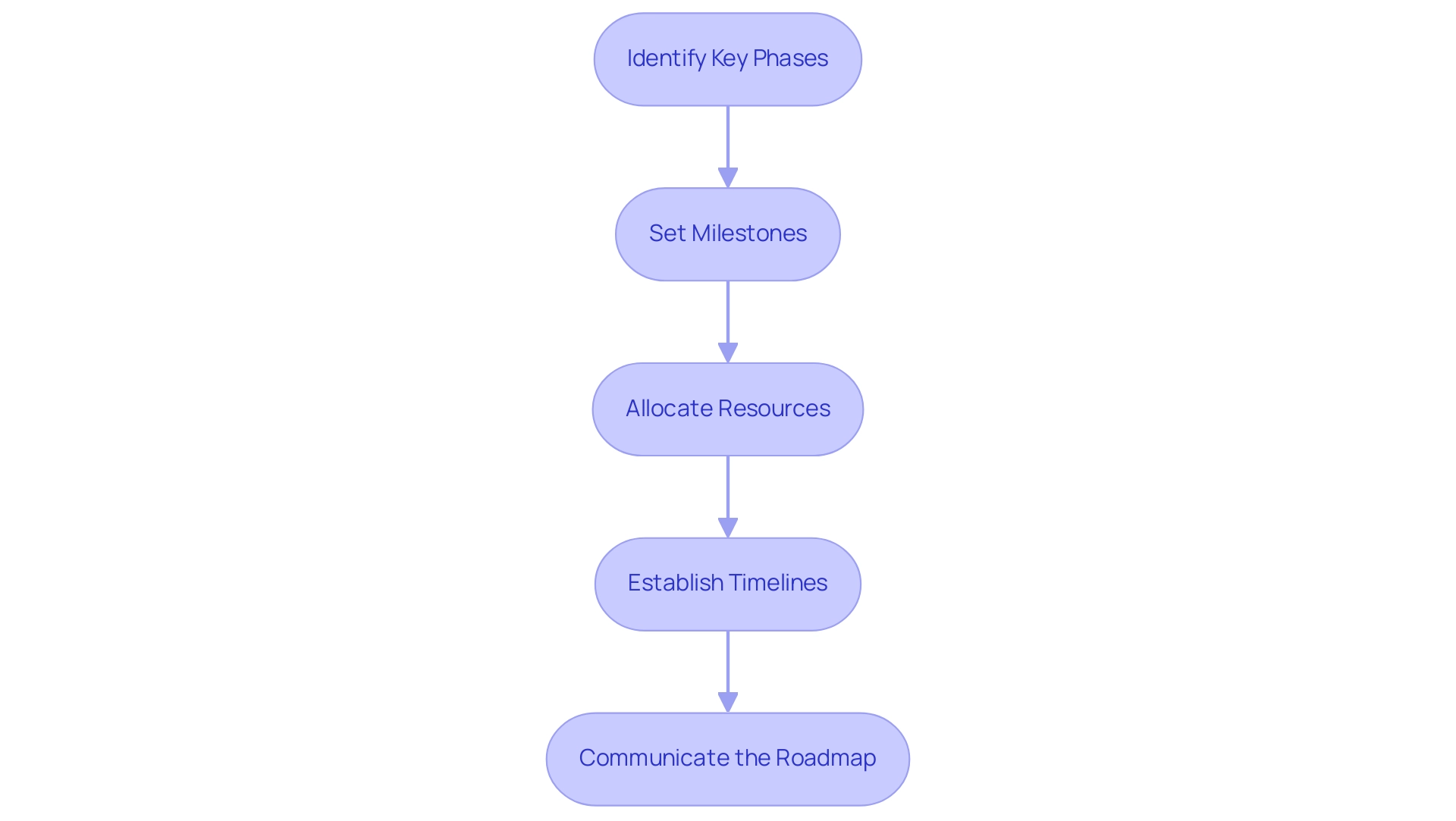
Securing Executive Buy-In: Engaging Stakeholders for Success
Gaining executive support for your devops strategy roadmap is essential for effective implementation. Consider the following approaches:
- Articulate the Value Proposition: Clearly delineate how development and operations initiatives will not only drive business value but also streamline operational efficiency and enhance customer experiences.
Highlight that companies implementing a collaborative approach are likely to experience enhanced quality and flexibility. Notably, 19% of surveyed professionals in development operations work as software engineers or developers, showcasing the skilled workforce behind these initiatives.
- Present Data and Case Studies: Utilize compelling data and real-world case studies to illustrate the success of development and operations in similar organizations.
For instance, recent findings indicate that over half of surveyed teams utilize practices specifically for deploying containers, positioning containers as the leading deployment target for teams according to DORA. This statistic can serve as a persuasive element to executives hesitant about the transition.
- Involve Executives Early: Engage key stakeholders from the outset of the planning process.
This inclusion ensures that their insights and concerns are addressed, fostering a sense of ownership and commitment to the devops strategy roadmap.
- Establish a Governance Model: Define a robust governance structure that incorporates executive oversight.
This framework not only ensures accountability but also aligns the development and operations initiatives with the devops strategy roadmap, facilitating smoother integration with overarching business objectives.
- Communicate Progress Regularly: Maintain open lines of communication with executives throughout the implementation process.
Frequent updates on progress and accomplishments will strengthen their backing and trust in the strategy.
- Address Current Trends: Highlight current trends such as cloud cost management, which is becoming a key initiative for development and operations teams.
Numerous organizations continue to employ various unconnected tools, resulting in inefficiencies that can be alleviated through a unified approach.
By embracing these methods, organizations can effectively secure the essential executive support to advance their transformation.
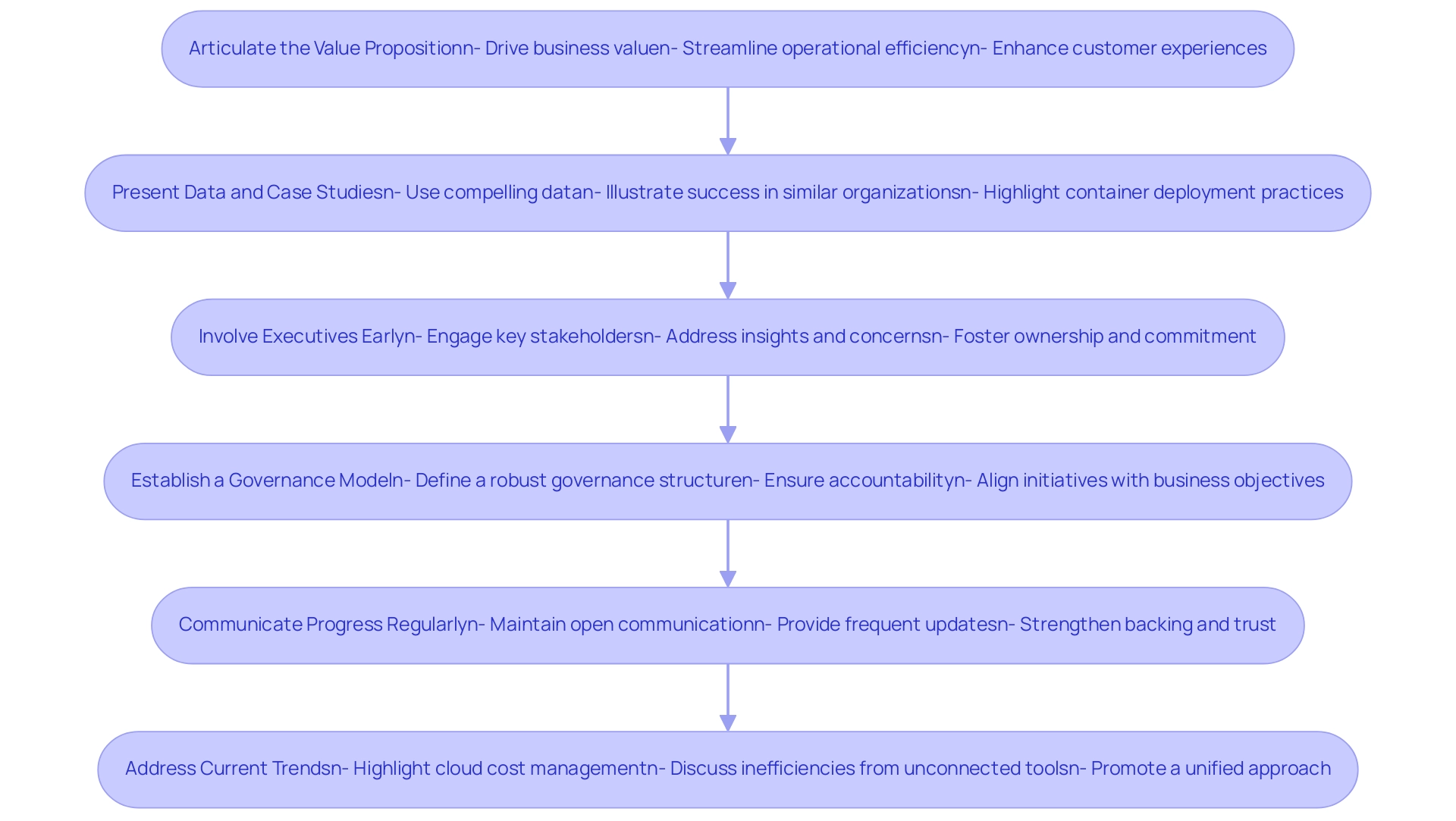
Continuous Improvement: Monitoring and Adapting Your DevOps Strategy
To ensure continuous enhancement in your development and operations strategy, consider implementing the following practices:
-
Establish Key Performance Indicators (KPIs): Defining robust KPIs is crucial for measuring the effectiveness of your DevOps initiatives. Key metrics to focus on include deployment frequency, lead time for changes, and mean time to recovery. Recent reports indicate that entities leveraging KPIs can enhance their operational efficiency by over 30% by identifying successful patterns and practices, demonstrating the importance of selecting the right metrics.
Regularly Review and Analyze Data: Conducting systematic reviews of performance data is essential. This practice not only helps identify areas for improvement but also validates the effectiveness of your strategies. Statistics show that organizations that adapt their tracking practices based on business needs and technological advancements consistently outperform their competitors in software development, with a reported 25% increase in project success rates. -
Solicit Feedback: Actively encouraging feedback from group members and stakeholders can shed light on challenges and opportunities for enhancement. Engaging your team in discussions around their experiences fosters a collaborative environment that promotes improvement.
-
Adapt and Iterate: Be prepared to dynamically adapt your strategy based on insights from data analysis and feedback. This flexibility ensures that your approach remains aligned with evolving business goals and market demands. The integration of AI and machine learning in DevOps tools enhances the accuracy of metrics analysis, enabling organizations to swiftly analyze vast amounts of data and make informed decisions that drive operational efficiency, as demonstrated in the case study on AI in DevOps.
-
Foster a Culture of Continuous Learning: Promoting a culture that values learning and experimentation is vital. Encourage teams to continuously innovate and improve processes, as this will enhance overall productivity and effectiveness. As Ben Lloyd Pearson emphasizes, understanding how the Quality Maturity Model integrates various dimensions of software quality with developer productivity metrics is key for better efficiency and strategy. By embedding these practices into your DevOps strategy roadmap, you will position your organization for success in 2024 and beyond.
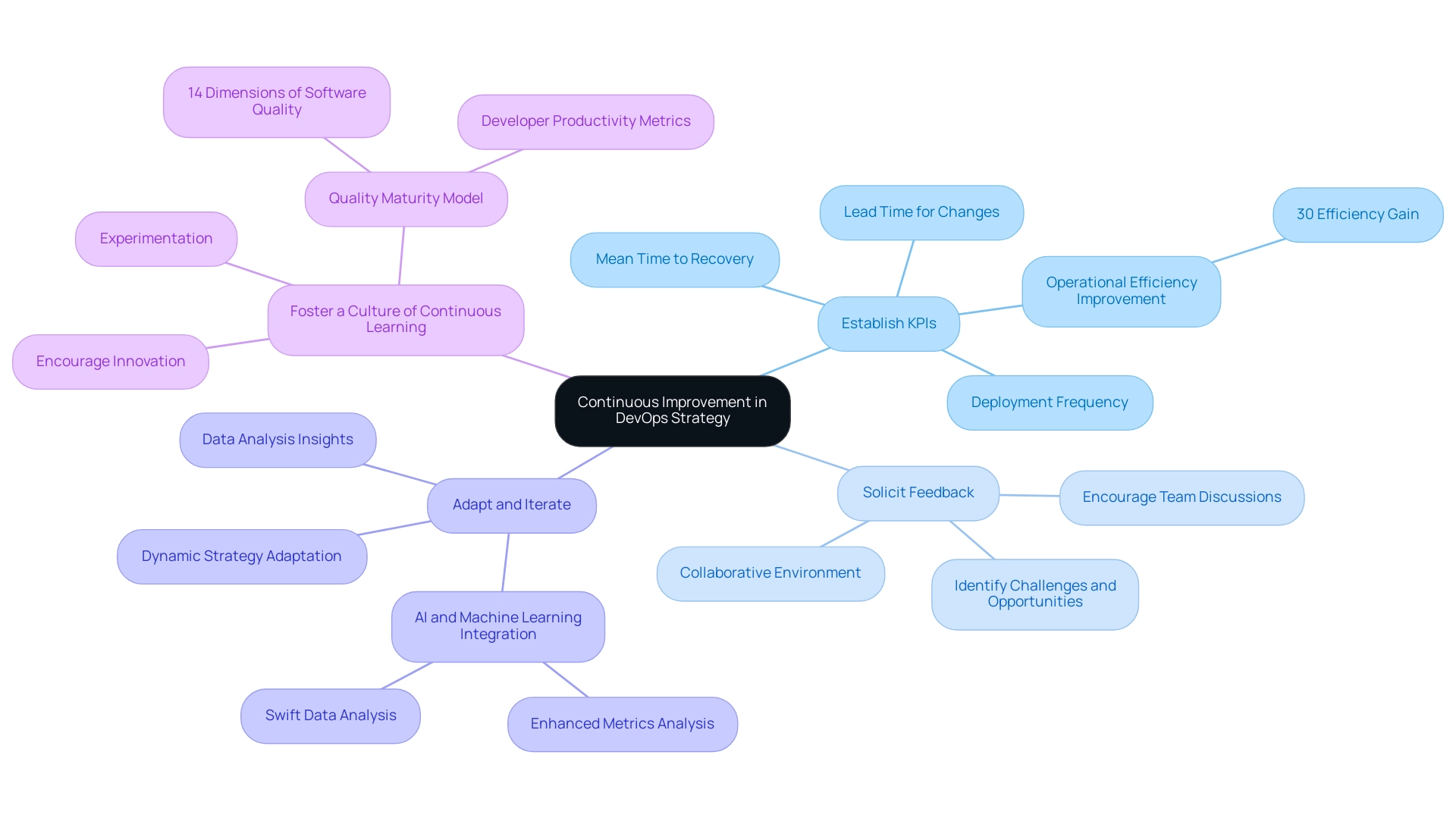
Conclusion
Embracing DevOps practices is essential for organizations looking to enhance collaboration, streamline processes, and ultimately improve the quality of software delivery. The core principles of DevOps—collaboration, automation, continuous integration and deployment, and real-time feedback—serve as the foundation for a successful strategy. By fostering a culture of shared responsibility and integrating automated solutions, organizations can navigate the complexities of modern software development more effectively.
Establishing a robust foundation begins with:
- A thorough assessment of current processes
- Engaging stakeholders
- Defining clear objectives
By creating a phased implementation roadmap, organizations can allocate resources efficiently and set realistic timelines, ensuring a structured approach that accommodates evolving market demands. Securing executive buy-in further solidifies the commitment to this transformation, as it aligns DevOps initiatives with overarching business goals.
Continuous improvement is vital to maintaining the effectiveness of any DevOps strategy. By establishing key performance indicators, soliciting feedback, and adapting strategies based on data insights, organizations can foster a culture of innovation and responsiveness. Ultimately, by adhering to these principles and practices, organizations position themselves not only to thrive in a competitive landscape but also to deliver high-quality software at an accelerated pace, paving the way for long-term success.




